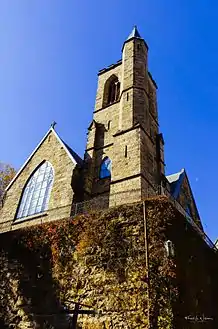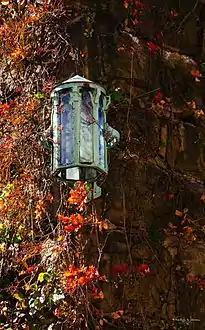St. Mark's Episcopal Church (Jim Thorpe, Pennsylvania)
St. Mark's Episcopal Church, now the Episcopal Parish of St. Mark and St. John, is a historic Episcopal church at 21 Race Street in Jim Thorpe, Carbon County, Pennsylvania. Completed in 1869, it is a prominent example of Gothic Revival architecture designed by that style's leading proponent, Richard Upjohn. It is one of Upjohn's last designs, and was largely funded by Asa Packer, a local millionaire whose fortunes were made in the coal fields. It was added to the National Register of Historic Places in 1977, and declared a National Historic Landmark in 1987.[2][3][4]
St. Mark's Episcopal Church | |
.jpg.webp) St. Mark's Episcopal Church, HABS Photo, 1979 | |
  | |
| Location | Race and Susquehanna Sts., Jim Thorpe, Pennsylvania |
|---|---|
| Coordinates | 40°51′46″N 75°44′21″W |
| Built | 1867–1869, 1887 |
| Architect | Richard Upjohn |
| Architectural style | Gothic Revival |
| NRHP reference No. | 77001135 |
| Significant dates | |
| Added to NRHP | July 26, 1977[1] |
| Designated NHL | December 23, 1987[2] |
Description and history
St. Mark's Church occupies a prominent location in the historic center of Mauch Chunk, as this part of Jim Thorpe was originally known, on the south side of Race Street just west of Susquehanna Street. It is a stone structure, built primarily out of local gray stone, with red stone as trim. It is set partly on natural terrace in a steeply sloping hillside, which has been extended and supported by a stone retaining wall. The church has a cruciform plan, with a square tower rising at the northeast corner. The outer corner of tower is extended by an octagonal stair turret, which rises a short way beyond the crenellated tower top to its own conical roof. The interior is tiered with the entrance and a small chapel at the lowest level, an intermediate level with another chapel, and then the main sanctuary. Movement between the levels is facilitated in part by a 1912 Otis elevator. The interior is lavishly appointed, with English tile, imported mahogany, and stained glass windows by Louis Comfort Tiffany and others.[3]
The church was designed by Richard Upjohn and was officially consecrated on October 25, 1869. The congregation was established in 1829, and its first church was completed on this site in 1848, with a formal consecration in 1852. The Mary Packer-Cummings Memorial Building, designed by Addison Hutton, was added to the church in 1912 when the 1912 Otis Cage Elevator was put in, this combine the two buildings that were once separate. However, the Memorial Building was originally built in 1881. Asa Packer was a vestryman for 44 years and warden for 24 years. He and his family donated considerable funds toward the construction of the church and its additions.[3]
The church is a late work of Upton's, and represents a relatively pure version of the Gothic Revival, well removed from the stylistic elements of the Greek Revival that he began his career with.[3]
The church congregation declined during the Great Depression, and it entered a cost-sharing agreement with Mauch Chunk's other Episcopal congregation, St. John's. The two were formally merged in 1980, and the St. John's church building was sold in 1984.
 Tower
Tower
 Lamp
Lamp
References
- "National Register Information System". National Register of Historic Places. National Park Service. April 15, 2008.
- "Saint Mark's Episcopal Church (Jim Thorpe)". National Historic Landmark summary listing. National Park Service. Retrieved 2008-06-29.
- Carolyn Pitts. "National Register of Historic Places Inventory-Nomination: Saint Mark's Episcopal Church" (pdf). National Park Service. Cite journal requires
|journal=(help) and Accompanying four photos from 1976 (32 KB) - "National Historic Landmarks & National Register of Historic Places in Pennsylvania" (Searchable database). CRGIS: Cultural Resources Geographic Information System. Note: This includes Sally McMurry (July 1974). 02H.pdf "National Register of Historic Places Inventory Nomination Form: St. Mark's Episcopal Church" Check
|url=value (help) (PDF). Retrieved 2012-10-30.
External links
| Wikimedia Commons has media related to St. Mark's Episcopal Church (Jim Thorpe, Pennsylvania). |

